Safe confined space surveys using UAVs are advanced inspection methods that employ drones to assess hazardous, enclosed areas without risking human entry. You'll benefit from enhanced safety, reduced costs, and improved data collection as UAVs navigate tight spaces with high-quality cameras and sensors. To guarantee safety, you must follow strict protocols, including risk assessments, detailed flight plans, and proper operator training. You'll need specialized equipment like compact drones with obstacle avoidance and reliable FPV systems. While challenges exist, such as limited battery life and navigation in GPS-poor environments, the future of UAV-based confined space surveys looks promising. Discover how this technology is transforming industrial inspections.
Key Takeaways
- Safe confined space surveys using UAVs involve remote inspections of hazardous enclosed areas using drones equipped with specialized sensors and cameras.
- These surveys eliminate the need for human entry, reducing risks associated with toxic gases, low oxygen levels, and physical hazards.
- UAVs for confined space surveys are equipped with obstacle avoidance sensors, high-quality cameras, and adjustable lighting for effective navigation and data collection.
- Operators must follow strict safety protocols, including risk assessments, detailed flight plans, and clear communication procedures during the survey.
- Challenges include limited battery life, navigation in GPS-denied environments, and regulatory compliance, which ongoing technological advancements aim to address.
Defining Confined Space Surveys
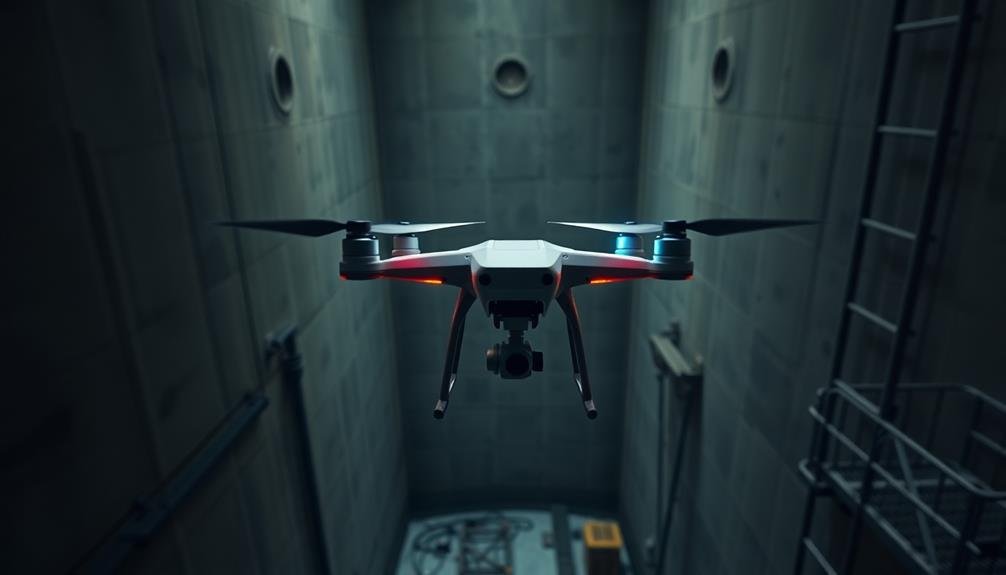
Confined space surveys are essential safety assessments conducted in areas with limited entry and exit points, potentially hazardous atmospheres, or other dangerous conditions.
These surveys help identify and evaluate risks in enclosed or partially enclosed spaces that aren't designed for continuous human occupancy. You'll find them vital in industries like construction, manufacturing, and utilities.
When you're conducting a confined space survey, you'll assess factors such as oxygen levels, toxic gases, flammable atmospheres, and physical hazards.
You'll also evaluate entry and exit points, ventilation systems, and emergency response procedures. The goal is to determine if it's safe for workers to enter and perform tasks within these spaces.
Confined space surveys typically involve a thorough inspection of the area, air quality testing, and documentation of findings.
You'll need to use specialized equipment like gas detectors, ventilation monitors, and personal protective gear.
The results of these surveys inform safety protocols, permit requirements, and training needs for workers who may need to enter these spaces.
Benefits of UAVs in Inspections
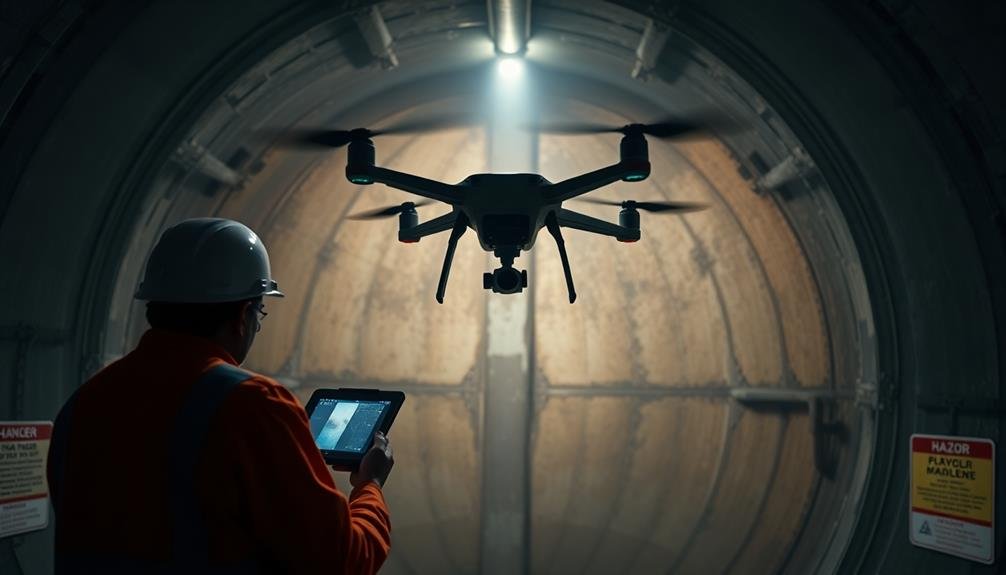
Unmanned Aerial Vehicles (UAVs) offer three key benefits for confined space inspections. They enhance safety by eliminating the need for human entry into hazardous environments, reduce inspection time and costs, and provide high-quality data for extensive assessments.
Safety is paramount in confined space surveys, and UAVs greatly minimize risks. You'll no longer need to expose personnel to potential dangers like toxic gases, unstable structures, or fall hazards. Instead, you can pilot the drone from a safe distance, capturing detailed imagery and sensor data without putting lives at risk.
UAVs also streamline the inspection process, saving you time and money. They can quickly access hard-to-reach areas, eliminating the need for scaffolding or specialized equipment. This efficiency translates to reduced downtime and lower operational costs.
The data collected by UAVs is invaluable for thorough assessments. You'll benefit from:
- High-resolution images for detailed visual inspections
- Thermal imaging to detect hidden issues like leaks or insulation problems
- 3D mapping capabilities for accurate measurements and spatial analysis
With these advantages, UAVs are revolutionizing confined space surveys, making them safer, faster, and more detailed than ever before.
Safety Protocols for Drone Operations
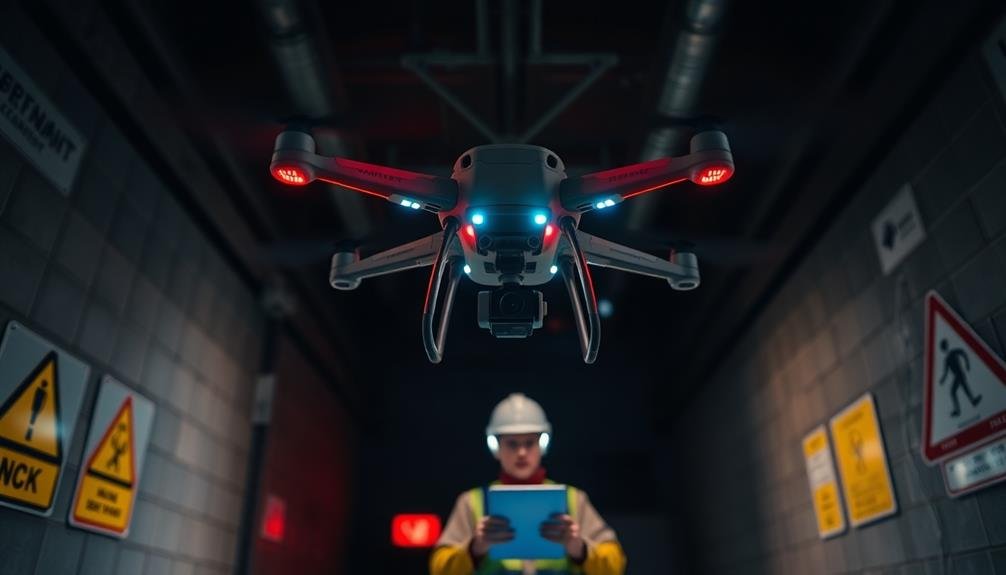
Safety stands at the forefront of UAV operations in confined spaces. You must establish clear protocols to guarantee the well-being of operators and equipment.
Begin by conducting a thorough risk assessment of the confined space, identifying potential hazards like poor lighting, obstacles, or toxic gases. Develop a detailed flight plan that accounts for these risks and establishes emergency procedures.
Guarantee your drone operators are properly trained and certified for confined space operations. They should be familiar with the specific UAV model and its capabilities in tight environments.
Always use a spotter to maintain visual contact with the drone and assist in navigation. Equip your UAV with appropriate safety features, such as propeller guards and collision avoidance systems.
Implement a pre-flight checklist to verify all systems are functioning correctly. Monitor battery levels closely, as confined spaces may limit landing options.
Establish clear communication protocols between the pilot, spotter, and any additional team members. Use reliable communication devices that work in the confined environment.
Equipment and Technology Requirements
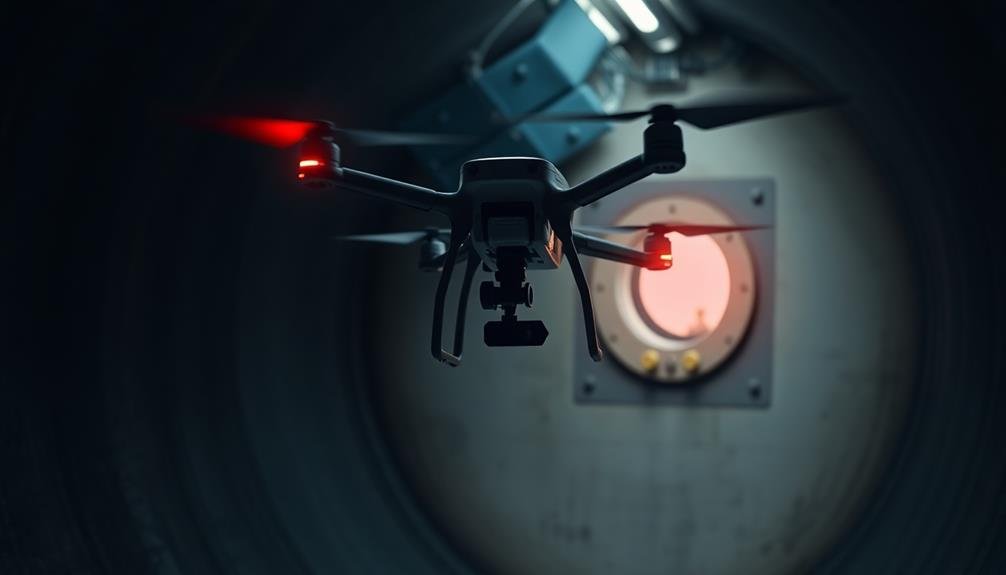
Selecting the right equipment and technology is paramount for successful UAV operations in confined spaces. You'll need a UAV specifically designed for indoor flight, equipped with obstacle avoidance sensors and propeller guards.
Choose a drone with a compact frame that can maneuver through tight spaces while maintaining stability. Your UAV should have a high-quality camera system for clear visual inspection. Opt for a model with adjustable lighting to illuminate dark areas and thermal imaging capabilities for detecting heat signatures or anomalies.
Confirm your drone has a reliable First Person View (FPV) system to maintain visual contact in enclosed environments.
Consider these essential technological features:
- Advanced collision avoidance systems using LiDAR or ultrasonic sensors
- Real-time 3D mapping capabilities for creating digital twins of confined spaces
- Extended flight time batteries or tethered power options for prolonged inspections
You'll also need a robust communication system that can maintain a strong signal in challenging environments. Choose a controller with a long-range transmission and interference resistance.
Don't forget backup batteries, spare propellers, and a toolkit for on-site repairs. Finally, invest in data storage and processing software to analyze the collected information efficiently.
Challenges and Future Developments
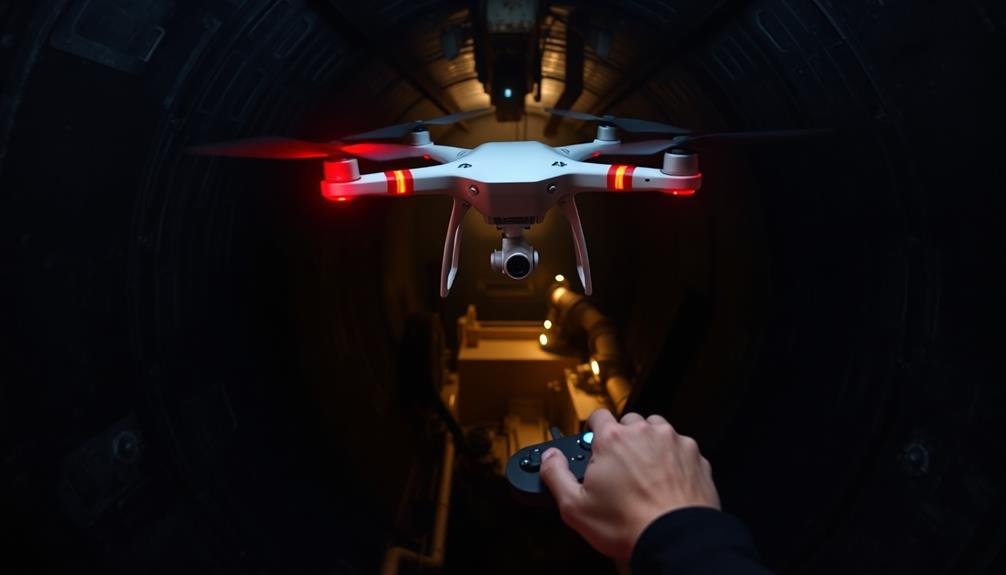
Despite the advantages of using UAVs for confined space surveys, significant challenges remain. You'll need to address issues like limited battery life, which can restrict flight time and survey coverage.
Navigation in tight spaces poses difficulties, as GPS signals may be weak or nonexistent. Lighting conditions can be poor, affecting image quality and data collection accuracy.
You'll also face regulatory hurdles, as many countries have strict rules governing UAV use in industrial settings. Operator training and certification requirements add complexity to implementation. Data security and privacy concerns must be addressed, especially when surveying sensitive areas.
Looking ahead, you can expect rapid advancements in UAV technology. Improved sensors, longer-lasting batteries, and enhanced collision avoidance systems will expand capabilities.
Machine learning algorithms will automate data analysis, speeding up decision-making processes. Miniaturization of UAVs will allow access to even tighter spaces.
Future developments may include swarm technology, enabling multiple UAVs to work together for more thorough surveys. Integration with other technologies, such as augmented reality, could provide real-time data visualization.
As regulations evolve, you'll likely see increased adoption of UAVs for confined space surveys across industries.
Frequently Asked Questions
How Long Does a Typical Confined Space Survey Using UAVS Take?
You'll find that a typical confined space survey using UAVs can take anywhere from 30 minutes to several hours. It depends on the size and complexity of the space you're surveying and the specific requirements of your inspection.
What Certifications Are Required for Operators Conducting UAV Confined Space Surveys?
You'll need a Part 107 FAA certification for commercial drone operations. It's also recommended to have confined space entry training and industry-specific certifications like OSHA safety courses or specialized UAV inspection certifications for your particular field.
Can UAVS Be Used for Confined Space Surveys in Explosive Atmospheres?
You can't use regular UAVs in explosive atmospheres. You'll need specialized drones certified for hazardous environments. They're designed with intrinsically safe components to prevent sparks or ignition sources. Always check local regulations before operating in such areas.
Are There Size Limitations for UAVS in Confined Space Surveys?
Yes, there are size limitations for UAVs in confined space surveys. You'll need to contemplate the dimensions of the space you're inspecting. Smaller drones are often necessary to navigate tight areas and avoid obstacles effectively.
How Do Weather Conditions Affect UAV Performance in Confined Space Surveys?
You'll find that weather doesn't markedly impact UAVs in confined spaces. However, strong drafts or temperature fluctuations can affect stability. It's best to choose UAVs with robust stabilization systems and conduct surveys in controlled conditions.
In Summary
You've learned how UAVs revolutionize confined space surveys, offering safer and more efficient inspections. By following strict safety protocols and using specialized equipment, you're able to gather essential data without risking human entry. While challenges remain, ongoing technological advancements promise even more precise and versatile drone operations. As you embrace this innovative approach, you'll continue to improve workplace safety and streamline inspection processes across various industries.

As educators and advocates for responsible drone use, we’re committed to sharing our knowledge and expertise with aspiring aerial photographers.




Leave a Reply